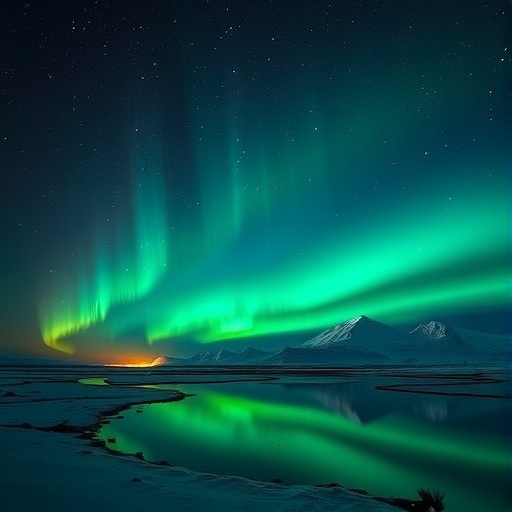Planetary scientists have made significant strides in understanding the aurora phenomena on Mars, transitioning from mere speculation to the ability to predict these natural light displays in the Martian night sky. For the first time, the NASA Perseverance rover, equipped with advanced imaging technologies, has captured the unmistakable green glow of an aurora, thereby providing not just visual confirmation of previous hypotheses but also a foundation for developing predictive models that could inform future missions to the Red Planet.
The recent developments surrounding these auroras have been unveiled during the Europlanet Science Congress, where Dr. Elise Wright Knutsen of the University of Oslo presented compelling findings. Based on data collected by the Perseverance rover, the research highlights a second observation of Martian auroras and introduces tools designed to forecast when these bright displays are likely to occur. This builds upon the rover’s pioneering efforts from 2024 when the first visible-light aurora was documented from Martian soil. Such advancements could prove crucial for future human exploration, especially as they address the inherent dangers posed to astronauts by solar activity.
Auroras are the spectacular visual effects that occur when energetic particles emitted by the sun—particularly during intense solar events known as coronal mass ejections (CMEs)—interact with the atmospheric molecules of a planet. On Earth, auroras typically manifest near the magnetic poles, a consequence of our planet’s protective magnetic field channeling solar particles toward those regions. However, Mars presents a different scenario: lacking a global magnetic field, auroras here are disseminated more broadly, leading to the phenomenon of “diffuse auroras” visible across the entire night side.
While this diffuse nature enables potential visibility to human observers on Mars, it poses a significant challenge for those tasked with long-term planning for manned missions. The radiation that triggers auroras can also pose risks, making real-time alerts essential for astronaut safety. The ability to forecast solar storms that might lead to auroras could be the difference between life and death in extreme Martian conditions. Therefore, the research team emphasizes the importance of not just capturing these visuals but understanding the accompanying solar phenomena that trigger them.
Yet, predicting auroras on Mars is a complex venture steeped in challenges. The efforts made by Knutsen’s team have not yielded consistent results. Observations must be meticulously planned and submitted to the rover three days in advance—a timeline that neither permits spontaneity nor guarantees successful outcomes. With eight attempts to observe auroras between 2023 and 2024, the process becomes one of trial and error, revealing the multifactorial nature of solar interactions with the Martian atmosphere.
Initial attempts to measure auroras yielded disappointing results. However, through a retrospective analysis of data from NASA’s MAVEN and ESA’s Mars Express missions, researchers identified that the solar wind conditions were insufficient to produce auroras during the first three attempts. That understanding paved the way for a more effective targeting strategy. The focus shifted toward faster and more intense CMEs. Encouragingly, these new targets led to the successful capture of two separate auroral events.
Interestingly, subsequent solar storm events that met all observational criteria led to no auroras, illustrating the inherent unpredictability still associated with these phenomena. Such unpredictability is not unique to Mars; Earth scientists struggle with similar challenges when forecasting auroral activity. The complexity of solar wind dynamics and their interactions with planetary atmospheres renders aurora prediction an imperfect science.
Each observation of auroral activity contributes to a growing dataset aimed at enhancing the accuracy of future predictions. Making sense of these observations involves correlating the timing of solar disturbances, assessing the arrival of solar energetic particles, and measuring auroral intensity. This multifaceted approach allows scientists to inch closer to figuring out the mechanisms that drive these stunning light displays on Mars, especially in the absence of a confining global magnetic field.
Such research not only fills knowledge gaps about the Martian atmosphere and its interaction with solar activity but also refines our understanding of space weather’s broader implications. As human missions to Mars become a tangible possibility, acquiring predictive capabilities regarding solar storms will be vital for mission safety and success. The collaboration of different space agencies, such as with NASA and ESA, creates a rich framework for ongoing planetary science endeavors.
Through continued observations, scientists hope to demystify the Martian auroras further, unraveling the myriad factors at play in their production. Each captured event will help assess how solar wind interacts with a planet that offers a markedly different environment than that of Earth. Moreover, with each new finding, the readiness for human exploration advances a step closer, making the dream of living and working on Mars progressively more feasible.
The auroras of Mars serve as a fascinating amalgam of science and spectacle, captivating imaginations while prompting critical research. Understanding how these wonders manifest could unlock profound insights not just into Mars, but into planetary atmospheres and solar interactions at large. As we dive deeper into the Martian mysteries, the understanding of auroras could act as a springboard for broader astrophysical inquiries regarding other celestial bodies.
In conclusion, the work by Dr. Knutsen and her team exemplifies how perseverance in scientific inquiry leads to breakthroughs that pave the way for future exploration. Mars, with its enigmatic auroras, stands not just as a desolate landscape but as a beacon of unresolved mysteries ready to be unveiled through rigorous scientific pursuit.
Subject of Research: Martian Auroras
Article Title: Predicting the Enigmatic Auroras of Mars
News Publication Date: [Insert Date]
Web References: [Insert Web References]
References: [Insert References]
Image Credits: Alex McDougall-Page, University of Strathclyde/AstrollCareers.
Keywords
Auroras, Mars, Perseverance Rover, Solar Activity, Planetary Science, Space Exploration.




